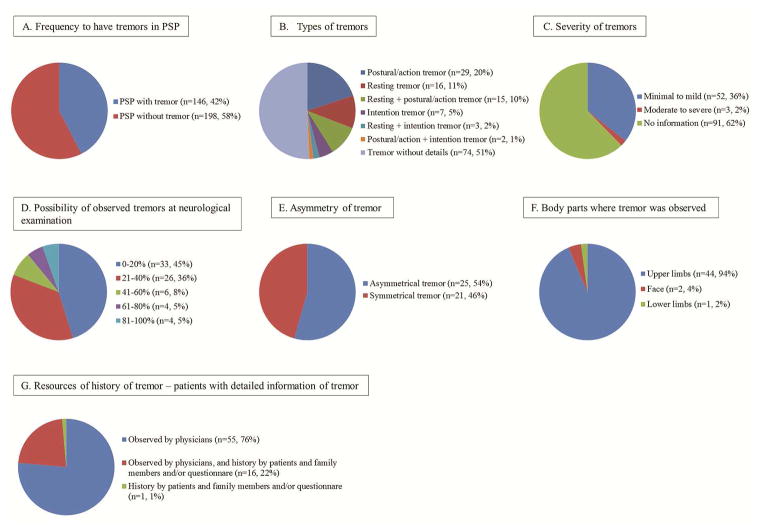Figure 1. A) Frequency of Tremor.
One hundred forty-nine of the 344 cases (42%) who had a documented presence or absence of tremor had reported having tremor at some point during the course of their illnesses. 1B) Types of Tremor: Postural/action tremor (n=29, 20%) were the most common form of tremor, which was followed by resting tremor (n=16, 11%), intention tremor (n=7, 5%), and a combination of different kinds of tremor (n=20, 13%). However, the details about the types of tremor were not available for the remaining 74 patients (51%). 1C) Severity of Tremor: Among the patients whose information about tremor severity was available (n=55), 52 (95%) had minimal to mild degree of tremor, and three (2%) had a moderate to marked degree of tremor. 1D) Probability of observing tremor: The probability of a physician observing tremor in patients who had the evaluated presence of tremor at least twice during the course of their illness or in those who received a comprehensive neurological examination that included an evaluation of the cranial nerves and an assessment of coordination and reflexes, including motor, sensory, and deep tendon reflexes are as follows: 0–20% for 33 patients (45%), 21–40% for 26 patients (36%), 41–60% 6 patients (8%), 61–80% for 4 patients (5%), and 81–100% for 4 patients (5%) (median 22% [7–33%]). 1E) Asymmetry of tremor: Among the 46 patients whose information about asymmetrical tremor was available, 25 patients were reported to have asymmetry. 1F) Locations of observed tremor: Among the patients (n=47) who had descriptions of tremor locations, 44 patients (94%) had tremor in their upper limbs, 2 patients (4%) had facial tremor, and 1 patient (2%) had tremor in the lower limbs. 1G) Resources of history of tremor: For patients with detailed tremor information, tremor was most frequently confirmed by physicians (n=55, 76%), followed by confirmation by both physicians and by medical histories provided by patients, family members, and questionnaires (n=16, 22%), and finally by confirmation only from the medical histories provided by patients, family members, and questionnaires (n=1, 1%).

